In London recently buying a small collection of books near Palace Gate I spotted three Bentley Bentaygas parked casually along the neighborhood streets. The one pictured can reach 190 mph and will leave little change from £150K. The ultimate SUV, 4 by 4, ‘Chelsea tractor.’ On showing this photo to a colleague, something of a ‘petrol head’, he informed me that there were certain areas of London that (young) tourists visit just to see rare and expensive supercars in the flesh – Mayfair, Chelsea, Belgravia mainly. He said that the visitors sometimes encourage the owners, often young Middle Eastern guys, to rev them up. In one instance the driver forgot he was in gear and shot forward into another supercar wrecking both. I blame Jeremy Clarkson..
he informed me that there were certain areas of London that (young) tourists visit just to see rare and expensive supercars in the flesh – Mayfair, Chelsea, Belgravia mainly. He said that the visitors sometimes encourage the owners, often young Middle Eastern guys, to rev them up. In one instance the driver forgot he was in gear and shot forward into another supercar wrecking both. I blame Jeremy Clarkson..
A Flight of Fancy: Lee-on-Solent’s Swordfish Hotel
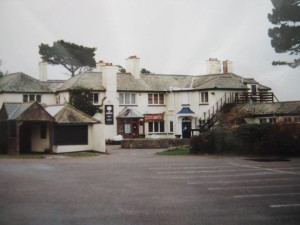 Alas, good eating places, whether pubs, hotels or restaurants, often come to sticky ends. They close down and when they re-open are often a shadow of their former selves. They frequently burn down, either deliberately to claim insurance, or by accident when a deep fat fryer goes up in flames.
Alas, good eating places, whether pubs, hotels or restaurants, often come to sticky ends. They close down and when they re-open are often a shadow of their former selves. They frequently burn down, either deliberately to claim insurance, or by accident when a deep fat fryer goes up in flames.
Destruction by fire was the fate of one of the more unusual eating places in the 1961 Good Food Guide. The Swordfish Hotel, on Crofton Cliffs in Lee – on- Solent was a much-loved attraction on the Hampshire coast, between Gosport and Southampton. It boasted a superb view of the Solent, had its own beach, and in 1961 was serving weird starters, such as fried silk worms and roasted caterpillars. More significantly, its chef was trained, in the words of Raymond Postgate ‘at that nursery of good cooks, the Westminster Technical College ’. Continue reading
Parkes’ Restaurant—eating place of the swinging sixties
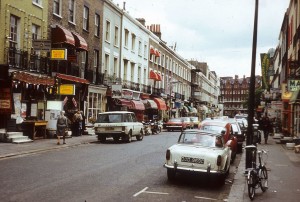 In his Good Food Guide of 1961-62 Raymond Postgate describes the trendy Parkes’ Restaurant at Beauchamp Place (above) in Kensington as ‘ a personal restaurant, dependent upon Mr Ray Parkes, the chef and owner, who offers in his basement at high prices what is claimed to be , and up to date is, haute cuisine.’
In his Good Food Guide of 1961-62 Raymond Postgate describes the trendy Parkes’ Restaurant at Beauchamp Place (above) in Kensington as ‘ a personal restaurant, dependent upon Mr Ray Parkes, the chef and owner, who offers in his basement at high prices what is claimed to be , and up to date is, haute cuisine.’
Postgate then complains of the ‘ exasperating whimsicality ‘ of such named dishes as ‘ Mr Goldstein’s Prawns’ (15/6), ‘Ugly Duckling’ (25/-), ‘Sweet Mysteries of Life’ (21/-). However, Postgate admires the fact that the ‘very inventive ‘ Parkes was always creating new dishes and provided such large helpings that ‘ the place isn’t quite as dear as it sounds’. Some Jot readers who dined at Parkes’ might recall what these whimsically named dishes actually were.
Parkes is credited with being a pioneer of the nouvelle cuisine revolution that properly began in the seventies, but the conventionally named dishes cited by Postgate, including ‘fillet of beef en croute’ and ‘duck and truffle pate’ don’t sound particularly ‘ nouvelle’. Nevertheless, in his time Ray Parkes was rightly considered an ‘original genius ‘. Egon Ronay described him as ‘ absolutely unique ‘, and the author of British Gastronomy, Gregory Houston Bowden, wrote: ‘ Many experts rate him almost on a par with the chef that he himself admired most, Ferdnand Point of the ‘Restaurant de la Pyramide’ in Vienne.
In addition to his eccentricy as a chef, Parkes was also unusual in that he had no licence. Diners were invited to bring their own wine. Another attraction for the many show-biz clientele that tended to eat at Parkes’ was the fact that it might be open until 2.30 in the morning. [R.M.Healey]
The Channel Islands Monthly Review
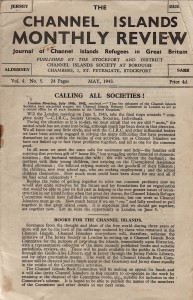 When, with the expected takeover of the German troops during the beginning of the Second World War, much of the population of the Channels Islands was evacuated to mainland Britain, Channel Island Societies were established here to serve the needs of the exiles. In time, the Channel Island Monthly Review was established, making it possible for both the exiled and the stay-at-home Islanders to communicate with each other.
When, with the expected takeover of the German troops during the beginning of the Second World War, much of the population of the Channels Islands was evacuated to mainland Britain, Channel Island Societies were established here to serve the needs of the exiles. In time, the Channel Island Monthly Review was established, making it possible for both the exiled and the stay-at-home Islanders to communicate with each other.
Published by the Stockport and District Channel Islands Society from 1940, this A5 sized digest of news proved a godsend, especially to the evacuees. It reported events in the Islands, the activities (whist drives, outings, and talks) of all the various Channel Island Societies in the UK, letters from those who stayed behind, and lists of those Islanders who had been deported to German internment camps. The magazine also carried Births, Marriages and Death notices, adverts and personal enquiries.
For instance, the issue for May 1943 carried a feature describing the still unresolved difficulties faced by the exiles, who were:
‘…struggling under financial or domestic anxieties; the husband without the wife; the wife without the husband ; the mothers with their young children, just existing on the Unemployed Assistance Board allowance; the billeted relying entirely on the goodwill of their billetors; the children, now over school age, who are seeking employment; and the school children themselves…’ Continue reading
The Riviera Revisited (1939)
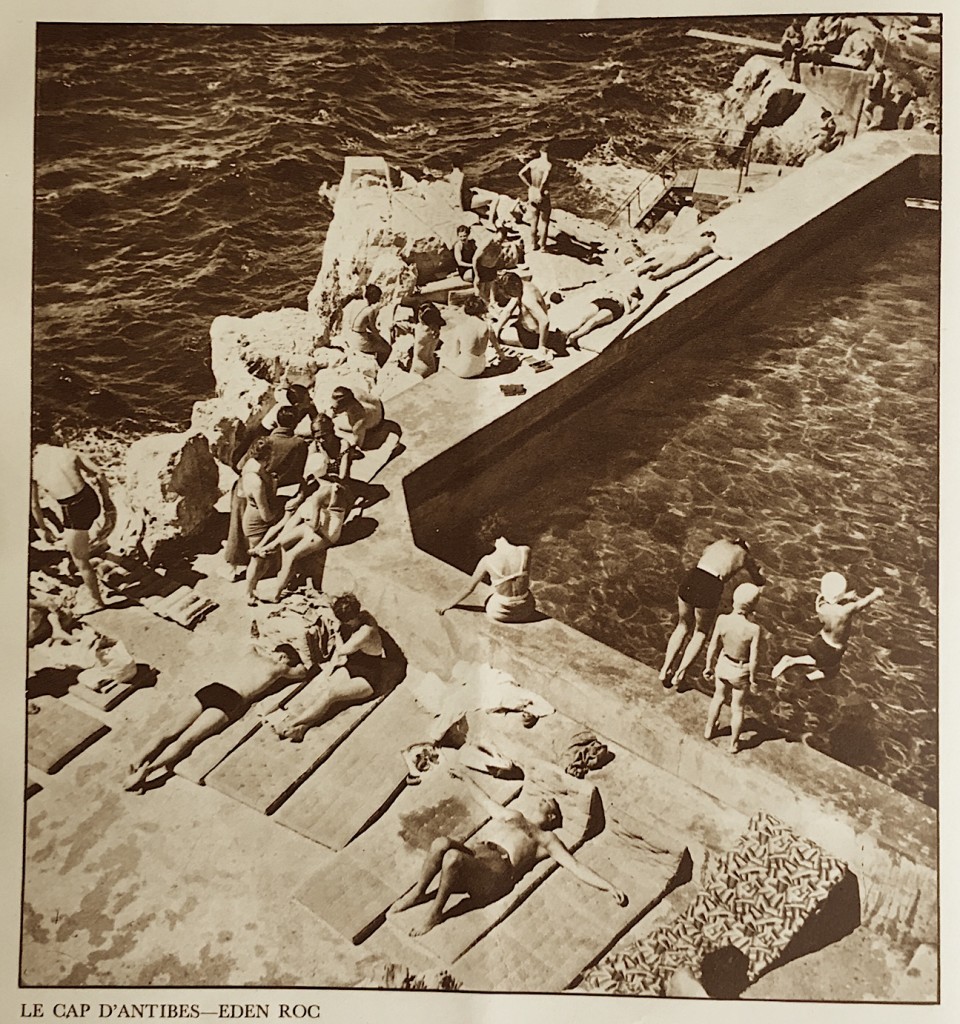 Found — a 30 page holiday brochure by Charles Graves – The Riviera Revisited. [London], [1939]. Probably written in 1938 and portraying a relaxed lifestyle, with plenty of good food and booze. Olive oil is not recommended as sun protection! After WW2 Charles Graves wrote 2 longer books on the Riviera – The Royal Riviera and (again) The Riviera Revisited… The picture of bathers at Eden Roc is from the booklet.
Found — a 30 page holiday brochure by Charles Graves – The Riviera Revisited. [London], [1939]. Probably written in 1938 and portraying a relaxed lifestyle, with plenty of good food and booze. Olive oil is not recommended as sun protection! After WW2 Charles Graves wrote 2 longer books on the Riviera – The Royal Riviera and (again) The Riviera Revisited… The picture of bathers at Eden Roc is from the booklet.
A Summer’s Day.
Juan-Les-Pins is the only resort I have ever visited four years in succession. I can think of no greater compliment. It has an admirable beach. It has a summer and winter season, like practically every other place on the Riviera. But whereas six or seven years ago the clientele was mainly English and American, it is now largely French, which I find charming. Somehow the prettiest girls from Paris go there for their summer holidays, and the restaurant of the casino has indubitably the best hors-d oeuvres in the world. The man who makes them is worth a fortune to any London restaurant or hotel. He stuffs everything with everything else. Pimentoes, aubergines, sardines, olives, tunny fish and so on. The casino is famous for the light-hearted character of its gambling. In the summer you wear white flannels or anything else. The croupiers smile (a distinct rarity). The champagne cocktails are first-class. The lobsters are as fresh as God made them; so are the crayfish. Let me quote from “And the Greeks”: Continue reading
An artist among the Charing Cross Road bookshops
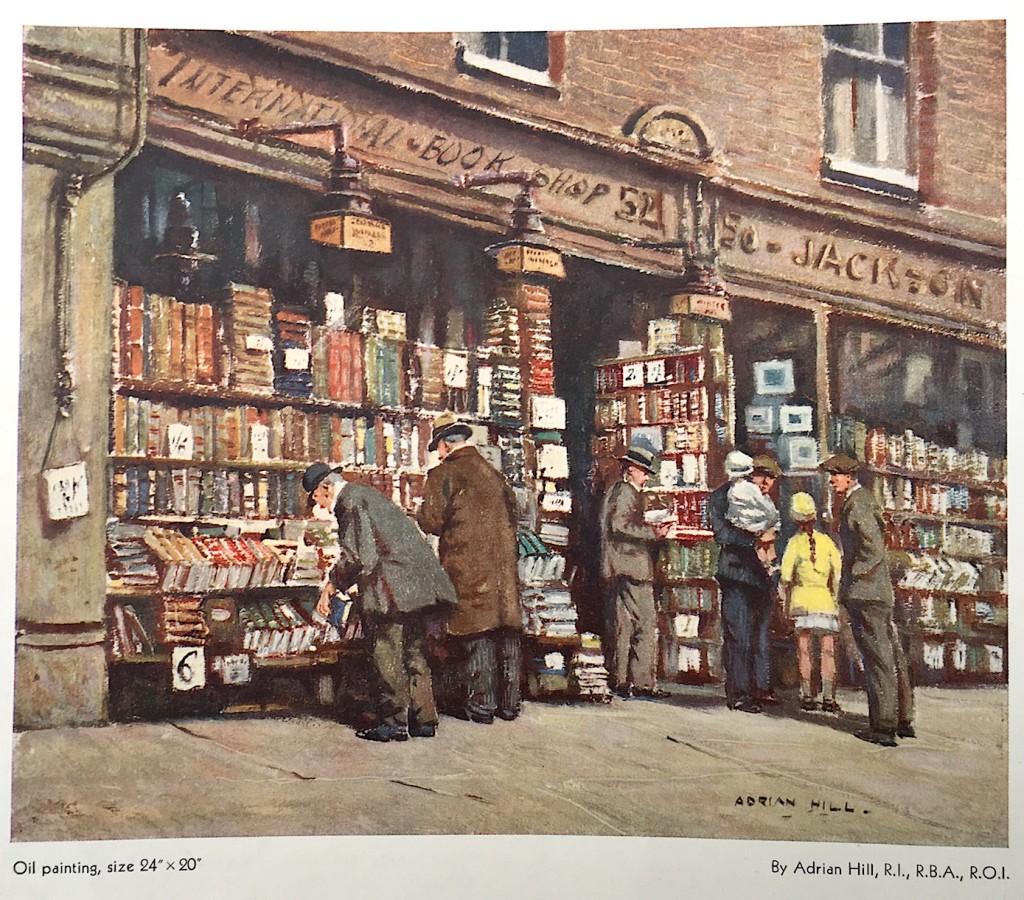 Found in the art instruction magazine The Artist (London, November 1934) an interview with the artist and art therapist Adrian Hill about his recent oil painting ‘In Charing Cross Road.’ Here are a few extracts -most of Hill’s talk is about technique, but there are some insights on the choice of subject:
Found in the art instruction magazine The Artist (London, November 1934) an interview with the artist and art therapist Adrian Hill about his recent oil painting ‘In Charing Cross Road.’ Here are a few extracts -most of Hill’s talk is about technique, but there are some insights on the choice of subject:
… there were some who questioned the impulse behind the work, and wondered whether the scene was worth the skill and discernment that the artist had brought to the task
I admit that I shared a little of this feeling. Charing Cross Road is a central and important thoroughfare, but it must rank in the C3 class amongst London highways. Indeed, there is so little of the beautiful or the picturesque about the neighbourhood that I asked Adrian Hill if the idea of sitting down to paint it came to him suddenly, or if he had deliberately hunted for such a subject.
“No, I wasn’t looking for it,” he said. “It came to me. It was a gift from the London traffic. I was waiting to cross the road when I suddenly found it in front of me, complete in design and detail, asking to be painted.”
“As far as size is concerned, did you see it as a 24″by 20″?”
“No, I thought at first of making it bigger – about 40″ by 30″ – but it was an experiment in the ay of subject, and I decided to go modest. If ever I do a similar scene, I shan’t hesitate to paint it on a grander scale!”
“You had no misgivings about tackling it inside the studio?”
“None at all. I believe I should have painted it mush less spontaneously and confidently if I had had the subject in front of me. The details would have been so insistent that I should have been led into making a still life study of books instead of an impression of a bookshop, which was what I was after.”
“But I suppose you had to use a model for the books?” Continue reading
Cabaret, Chinese food and national anthems in Yorkshire’s most eccentric pub
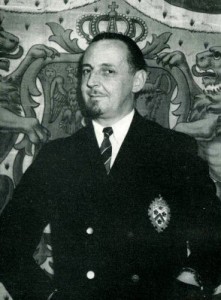 An entry in the 1961- 62 edition of The Good Food Guide describes the exuberant John Showers and his’ inn’, the Stanhope in Calverley Lane, Rodley, south east of Leeds, thus:
An entry in the 1961- 62 edition of The Good Food Guide describes the exuberant John Showers and his’ inn’, the Stanhope in Calverley Lane, Rodley, south east of Leeds, thus:
‘He fills out the nightly menus with his own essays, and he has written two books about it. Foreign visitors, of which there are many, are liable to be welcomed in their own tongue (Mr Showers’circular green notepaper has Cheerio on it in thirty languages) and escorted to their tables to the sound of their own national anthem. There is a nightly cabaret, by no means undistinguished and not ‘blue’ for which he sometimes writes the script. The dining-room is very small, and serves some English dishes but ignore them ( except for no. 80 ’curried octopus’—so English, don’t you think?) and go for the Chinese food. Try, divided among a party, the Sea Salad (9/-), inkfish with bean sprouts (8/-), Stanhope Special ( based on chicken , pork and water-chestnuts, 8/ 6) or ask for some advice…
Reading the two books in question one will discover that before he opened The Stanhope, the Essex-born Showers was, among other things, a male manikin, bus conductor, and a banana planter. In 1937, inspired by the example of the new king and his consort playing darts publicly he installed a board in his saloon, hoping to attract the upper middle class. Alas, only the local proletariat came to play, and eventually the board was relocated to the tap-room. All of which recalls Basil Fawlty’s disastrous ‘gourmet night’ ! Continue reading
Havelock Ellis on British geniuses
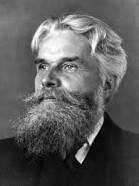 Found in a album of cuttings from various East Anglian newspapers in the early twentieth century is a review that appeared in The Leader, December 24th, 1906 of A Study of British Genius by the pioneer sexologist Havelock Ellis. The reviewer gleefully notes that East Anglia seems to have produced a high proportion of geniuses. To make his point he lists in order of greatness those English counties that have contributed most to the making of English men of genius. These were:
Found in a album of cuttings from various East Anglian newspapers in the early twentieth century is a review that appeared in The Leader, December 24th, 1906 of A Study of British Genius by the pioneer sexologist Havelock Ellis. The reviewer gleefully notes that East Anglia seems to have produced a high proportion of geniuses. To make his point he lists in order of greatness those English counties that have contributed most to the making of English men of genius. These were:
Norfolk
Suffolk
Hertfordshire
Warwickshire
Worcestershire
Herefordshire
Buckinghamshire
Cornwall
Dorsetshire
Oxfordshire
Shropshire
Ellis looked at the genius’s place of origin—that is, the district to which his four grandparents belonged. London as a birthplace was ignored altogether. This was because, where information was available, it was nearly always found that the parents had migrated to London. It rarely occurred that ‘even one grandparent belonged to London ‘. Continue reading
A new kind of bookshop in 1930s New York City
 Discovered in a copy of The Publisher’s Weekly for March 22nd 1930 is this feature by John D. Stannard on a New York bookshop that aimed, with its decorations and objets d’art, to emulate the comfort and charm of a private library.
Discovered in a copy of The Publisher’s Weekly for March 22nd 1930 is this feature by John D. Stannard on a New York bookshop that aimed, with its decorations and objets d’art, to emulate the comfort and charm of a private library.
Elizabeth Drew, a graduate of Vassar College and her ‘ associate’ , the artist Jessie Leach Rector, opened their (unnamed) shop on 43 East 60th Street in September, 1929, just a few weeks before the Wall Street Crash. Designed to be an antidote to the ‘ graceless ‘stores that most booklovers had become used to, the couple had created a ‘ bookish background’ in which old furniture and rare objects of art competed with books for the attention of customers.
Everything in the shop was for sale, including the ‘ lamps, lampshades, old prints and watercolours, framed and unframed mirrors, screens and tables’ provided by Rector, who specialised in interior decoration, and the ‘primitive Indian pottery and Spanish colonial silver which Drew imported from Peru. Drew emphasised that although her store was sophisticated, had an exclusive list of patrons, and sold old and rare books, including modern first editions and fine bindings, her ideal customer was the ‘middle-class ‘type who travelled into town on the subway.
A key innovation devised by Drew was the monthly review of new books in the fields of fiction, biography, essays, Book-of-the Month, Literary Guild, Crime Club and best sellers, which was sent out to a hand picked 6,000 names, half of whom came from friends of the two booksellers, and which bore the testimonial ‘ Recommended by Elizabeth Drew’. In fact, the reviews came not only from Drew herself, but by these friends, who signed their work. Continue reading
Bruce Calvert—the man who cancelled Christmas
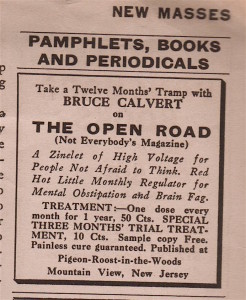 Found in the classified column of The New Masses for May 1927 is this advert for The Open Road, a monthly magazine described by its founding editor, Bruce Calvert, as ‘A Zinelet of High Voltage for People Not Afraid to Think’ and a cure for ‘ Mental Obstipation and Brain Fag ‘.
Found in the classified column of The New Masses for May 1927 is this advert for The Open Road, a monthly magazine described by its founding editor, Bruce Calvert, as ‘A Zinelet of High Voltage for People Not Afraid to Think’ and a cure for ‘ Mental Obstipation and Brain Fag ‘.
Calvert, who ran the operation from his home in Pequannock , New Jersey, delightfully dubbed by him ‘Pigeon-Roost-in-the Woods’, had been a hard-bitten magazine editor in Chicago and Pennsylvania before moving to the backwoods of Griffiths, near Gary, in his home state of Indiana, to take up the life of an anarchist-freethinker inspired by, among others, Walt Whitman and Thoreau. In 1908 he had brought out the first issue of The Open Road, which appeared regularly until 1915. Espousing a philosophy of ‘right thinking and right living ‘, Calvert made his magazine a fount of various heterodoxies which delighted in offending straight-laced home-loving and family-orientated Americans. In April 1911 one of the most controversial issues challenged the hijacking of Christmas by commerce—a point of view which earned him the soubriquet of ‘Indiana’s Prize Crank ‘.
By November 1911 ‘The World League for a Sane Christmas’ had established its HQ in Room 431 of the State Life Building in downtown Indianapolis. Members who paid their $10 subscription could expect their money to go towards various planned publications as well as a booklet entitled The Christmas Insanity. Moreover, each new member was obliged to sign the following agreement:
‘I will from this time forward neither give nor accept Christmas presents outside my own immediate household, and I will do all I can by distributing literature and other propaganda work to discourage the senseless practice of indiscriminate Christmas giving, to the end that true human love and brotherhood may reign in the hearts of men instead of the maudlin insanity which now disgraces the day ‘ Continue reading
Going to the Sales in 1906
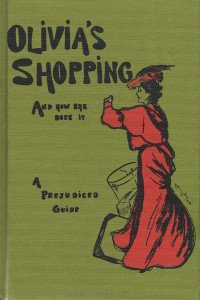 Now that the January sales appear to be in full swing it might be valuable to take the advice of the pseudonymous ‘ Olivia ‘, a copy of whose ‘ prejudiced guide to the London shops ‘of 1906 cropped up in a pile of books. This chatty and opinionated, and possibly American-born, veteran of West End emporia, took retail therapy to new heights in her search for quality, elegance and good value. Here’s what she has to say about the vexed matter of sales.
Now that the January sales appear to be in full swing it might be valuable to take the advice of the pseudonymous ‘ Olivia ‘, a copy of whose ‘ prejudiced guide to the London shops ‘of 1906 cropped up in a pile of books. This chatty and opinionated, and possibly American-born, veteran of West End emporia, took retail therapy to new heights in her search for quality, elegance and good value. Here’s what she has to say about the vexed matter of sales.
The magic word that stocks our wardrobes, deletes our purses, disorganizes our routine, fascinates us, repels us, delights us, disappoints us twice a year regularly in London—for how much is it not answerable?
The ethics of sales are so disturbing, one time so morally and clearly good, the next minute so conspicuously disappointing and bad, that no woman, I believe is quite settled in her mind regarding them.
Personally, I find it a delightful thing to buy a pretty piece of stuff ‘marked down ‘.Even when I can buy the same thing fresh and by the yard, and at the identical price, it never thrills as does that remnant with the wrong amount of yards, the torn edge, and the marked down price. There is no doubt we all love a bargain, even when it is only on paper.
This trait in our feminine character is fully appreciated by the shopkeeper. Therefore, there are sometimes disappointments to be encountered at sales. On the other hand, some of us attempt to remain level-headed in the matter, and are not to be won over. Continue reading
Guernsey – a WW2 Press Diary
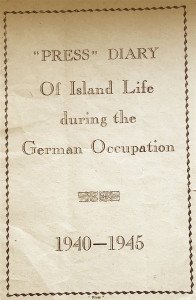 Found – a small 44-page wire-stitched newsprint pamphlet (no date or printer specified) entitled “PRESS” DIARY of Island Life during the German Occupation 1940-1945. Probably printed in Guernsey in late 1945. It records life under German occupation in Guernsey through short news items. It is much concerned with the many changing rules and proclamations by the Germans regarding cars, tobacco, potatoes, curfews, penalties for plunder of unoccupied premises (death) also it records local crime, entertainment and privations. Cigarette rations were down to 20 cigarettes a week and 2 oz of tobacco. Many notices are brief – ‘’Rat Destruction committee advertise for dogs and ferrets.’ ‘Owners of private cars ordered to report.’ ‘Potato Board report that shortage of potatoes is due to hoarding.’ ‘First case against cyclists for riding abreast. Fined 2/6 each.’ ‘Germans order collections of old bicycle tyres, and tubes, rags, old paper, feathers, rubber, bones, leather and unbroken glass bottles’ ‘Appeal for old felt hats for making into slippers.’
Found – a small 44-page wire-stitched newsprint pamphlet (no date or printer specified) entitled “PRESS” DIARY of Island Life during the German Occupation 1940-1945. Probably printed in Guernsey in late 1945. It records life under German occupation in Guernsey through short news items. It is much concerned with the many changing rules and proclamations by the Germans regarding cars, tobacco, potatoes, curfews, penalties for plunder of unoccupied premises (death) also it records local crime, entertainment and privations. Cigarette rations were down to 20 cigarettes a week and 2 oz of tobacco. Many notices are brief – ‘’Rat Destruction committee advertise for dogs and ferrets.’ ‘Owners of private cars ordered to report.’ ‘Potato Board report that shortage of potatoes is due to hoarding.’ ‘First case against cyclists for riding abreast. Fined 2/6 each.’ ‘Germans order collections of old bicycle tyres, and tubes, rags, old paper, feathers, rubber, bones, leather and unbroken glass bottles’ ‘Appeal for old felt hats for making into slippers.’
Ships arriving with supplies are noted including the one ton of delicacies- milk, chocolate, cheese and sweets donated to the island’s children by the Swiss International Red Cross in April 1941. The Guille-Allès Library of Guernsey allowed residents 2 books at a time (raised from one.) There were many burglaries and break-ins reported and several profiteers and black marketers arrested and fined. One man arrested for breaking into a house and stealing and assaulting a woman received 12 strokes of the whip and 5 years in prison, a few were summarily shot. Continue reading
Barbara Lea – a forgotten Fenland poet
Found – a copy of The Urgent Voice: and other poems by Barbara Lea (Fortune Press, London 1948.) She lead a short but productive life and is unknown to Wikipedia or any online database apart from Peerage.com who have a good factual entry* on her as, unusually for a Fortune Press poet, she was an aristocrat. The foreword is anonymous and it is just possible it is by Reginald Caton, the founder of the press but is more likely to be by a friend or family member. We append a good East Anglian poem by her after the foreword.
Barbara Lea (nee Pell) was born at Wilburton Manor in the Isle of Ely in 1903. She never lost her early passion for the Fenland, nor for the house in which she was born; indeed, she loved houses and places, before people, witness her poems ‘East Anglia Revisited’, ‘In Time of Trouble’, ‘First Visit’.
She married in 1924 and had five children, the last being born in 1934, and in spite of all the ties of home life, she became increasingly interested and active, in politics and the Women’s Institutes.
When the war started in 1939 she was on the Executive Committee of the National Federation of Women’s Institutes, as well as the Worcestershire Committee, and Chairman of the Woman’s Land Army in Worcestershire; a member of the County War Agriculture Committee, and was occupied by a large number of less onerous activities, such as Justice of the Peace, Guardians’ Committee, Parish Council, Parochial Church Council, District Nursing Association, and others too numerous to mention. In 1943 she was awarded the O.B.E. Continue reading
Maundy Gregory – a St John’s Wood Gatsby
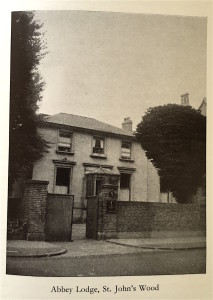 Found in a 1955 Punch – a review by the novelist Anthony Powell of Honours for Sale. The Strange Story of Maundy Gregory. (Gerald Macmillan, London: Richards Press 1954). Maundy Gregory had in the 1920s what amounted to a licence to print money. He sold honours, a profession that made a comeback in the Blair years. For £10,000 (about $1 million now) he could get you an earldom; knighthoods were a bit cheaper. You could, in fact, sign a cheque to him in your expected new name–only cashable when you assumed the title. He liked rare books, especially the works of the fantastical Frederick Rolfe (Baron Corvo.) In some cases (according to AJA Symons in Quest for Corvo) he would pay his agents to track down supposedly unfindable books, money no object. He had a mansion in St John’s Wood which later became the world famous Beatle’s recording studio.
Found in a 1955 Punch – a review by the novelist Anthony Powell of Honours for Sale. The Strange Story of Maundy Gregory. (Gerald Macmillan, London: Richards Press 1954). Maundy Gregory had in the 1920s what amounted to a licence to print money. He sold honours, a profession that made a comeback in the Blair years. For £10,000 (about $1 million now) he could get you an earldom; knighthoods were a bit cheaper. You could, in fact, sign a cheque to him in your expected new name–only cashable when you assumed the title. He liked rare books, especially the works of the fantastical Frederick Rolfe (Baron Corvo.) In some cases (according to AJA Symons in Quest for Corvo) he would pay his agents to track down supposedly unfindable books, money no object. He had a mansion in St John’s Wood which later became the world famous Beatle’s recording studio.
Powell calls him an ‘honours tout’, a ‘real life Gatsby’ and ‘a mad aspect of the 1920s incarnate’. He suggests that anyone ‘who enjoys a good laugh’ should read the list of guests at his Derby Eve Dinner at his own club ‘The Ambassador’s.’ Something of a ‘sausage fest’ (i.e. no women) but, as Powell says, Gregory certainly knew how to ‘bring them in.’ The author of the book, Gerald Macmillan, may be exaggerating when he says it was the most distinguished gathering ever held…
List of guests at Ambassador Derby Eve Dinner, held on June 2, 1931.
Major-General J. E. B. Seely (in the Chair), Sir Austen Chamberlain, Mr. Winston Churchill, the Duke of Marlborough, Mr. J. H. Thomas, the Duke of Sutherland, Viscount Craigavon, the Marquess of Reading, Major-General the Earl of Scarborough, Sir John Simon, Lord Southborough, Viscount Elibank, Mr. J. Maundy Gregory, Lord Jessel, Mr. Ralph E. Harwood, Earl Winterton, Lord Queenborough, Lord Bayford, Mr. W. Dudley Ward, Lord Plender, Marquis del Moral, Lieutenant-Commander Sir Warden Chilcott. Continue reading
Harry Grindell Matthews—inventor extraordinaire
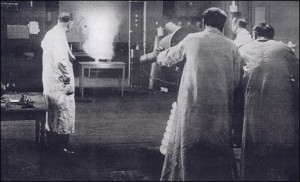
If ever a man was the epitome of the ‘mad inventor‘ it was Harry Grindell Matthews, though his many supporters would perhaps bridle at the word ‘ mad’. But if he wasn’t dotty, he was certainly controversial and decidedly eccentric. For it was the habit of this electrical engineer, born in Winterbourne, now a northern suburb of Bristol, in 1881, to claim a startlingly interesting innovation while refusing to cooperate with interested parties, including government agencies. In 1911 he claimed to have invented a radio-telephone, which if developed might have been a prototype of our modern mobile; he also boasted that he had created the world’s first talking movie in 1921, but this too was never financed. He is best known today ( if he is known at all) for inventing an invisible Death Ray which he claimed would stop electrical machinery at a distance, thus immobilising enemy threats, such as aircraft and bombs. However, when an eager government stipulated that to convince the scientists he would be required to stop a petrol-driven motorcycle engine remotely, Matthews refused the challenge. In this press photo dated 1930 from the London based Sports and General agency, which found its way into the marvellous El Mundo archive, Matthews is shown on the right, cigarette in hand, while a group of engineers eagerly examine what appears to be the motorcycle engine which he was asked to stop. In another photo we see Matthews operating the Death Ray itself. Needless to say, the inventor’s refusal to cooperate in a controlled experiment spelt the end of this promising piece of technology.
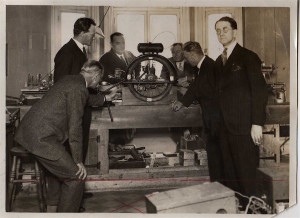
Undeterred, Matthews continued to offer new inventions. The most exciting was a Sky Projector, which he demonstrated with some success. Had this got off the ground we may have had laser-type shows in the 1930s. When at last he did manage to tempt serious investors to part with their money, he used much of it to build a state of the art laboratory and a private airfield overlooking the Swansea Valley at Clydach. His financial state received another boost in 1938 when he married an opera singer called Ganna Walska whose five former husbands had left her with a fortune of around $125m. Unfortunately, he did not live long to enjoy his good fortune. Matthews died in Swansea in 1941 at just 60.
Gloucestershire has produced at least another brilliant electrical engineer. Joe Meek, the equally eccentric electronic music pioneer who produced the cult favourite ‘Telstar’ in 1962, worked on radios as a teenage prodigy. His shed can still be seen at the rear of his father’s old shop (blue plaque) off the Market Place in Newent. [R.M.Healey]
London A to Z (1953)
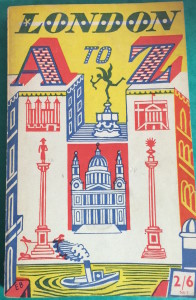 Found – this rare and attractive paperback guide to London published by Andre Deutsch in 1953 and illustrated by Edward Bawden. This extract of three entries gives the flavour
Found – this rare and attractive paperback guide to London published by Andre Deutsch in 1953 and illustrated by Edward Bawden. This extract of three entries gives the flavour
of the book. How many people raise their hats (head-gear?) when passing the Cenotaph in 2016? How many people still possess bowler hats and who could still call its football team ‘poor old Chelsea.’?
BOWLER HAT. The possession on of the correct type of bowler, hairy, not too large and curly-brimmed, is as essential to the young man about town as a pair of trousers. It is worn e either in the hand which is not carrying the rolled umbrella, or, sometimes, even on the head, tilted forward over the eyes at the angle adopted by villains in Victorian melodrama. The most London of all headgear…
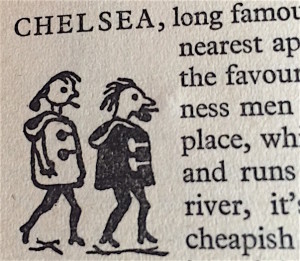 CENOTAPH. Designed by Sir Edwin Lutyens, the simple and auster national memorial to the dead of the Commonwealth in both world wars stands in the middle of Whitehall. It is the focal point of the nation’s morning on Remembrance Day. Men raise their hats when they pass it.
CENOTAPH. Designed by Sir Edwin Lutyens, the simple and auster national memorial to the dead of the Commonwealth in both world wars stands in the middle of Whitehall. It is the focal point of the nation’s morning on Remembrance Day. Men raise their hats when they pass it.
CHELSEA. Long famous as the home of artists, London’s nearest approach to a Latin Quarter, is now the favourite area of civil servants and businessmen as well.
An attractive and friendly place, which centres around the Kings Road and runs from Sloane Square down to the river, it’s studded with some very good cheapish restaurants, antique shops, drinking clubs. Both the men and women wear corduroy trousers. It also houses the Chelsea Football Club (at Stamford Bridge), long known as ‘poor old Chelsea,’ the despair and the delight – mostly the former – of its supporters.
Miguel de Unamuno on Fuerteventura
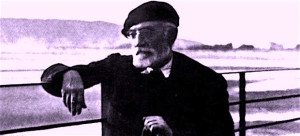 Found in Essays and soliloquies by Miguel de Unamuno (London: Harrap 1924) this preface written on the windswept Spanish island of Furteventura. The island is now mainly a holiday destination, although there is an impressive statue of Unamuno by the main road and also a life size statue of him on a side street. Unamuno was exiled to Fuerteventura in 1924 by the Spanish Government for his political ideas. His friend J.E. Crawford Flitch visited him there and prepared (and translated) this selection.
Found in Essays and soliloquies by Miguel de Unamuno (London: Harrap 1924) this preface written on the windswept Spanish island of Furteventura. The island is now mainly a holiday destination, although there is an impressive statue of Unamuno by the main road and also a life size statue of him on a side street. Unamuno was exiled to Fuerteventura in 1924 by the Spanish Government for his political ideas. His friend J.E. Crawford Flitch visited him there and prepared (and translated) this selection.
Author’s preface
I am writing these lines, today the 6th of June, 1924, in this island of Fuerteventura, an island that is propitious to calm thinking and to a laying bare of the soul, even as this parched land is bare, bare even to the bone. Here I have been confined now for nearly three months, no reason for my confined having been given other than the arbitrary mandate of the military power that is de-civilising and debasing my native country.
Hither came my friend Mr. J. E. Crawford Flitch to bear me company. He was entrusted by Mr. Alfred A. Knopf with the task of making an anthology or florilegium of my shorter articles and extracts from my more extensive writings which should present a conspectus of my whole literary work. It is he, my friend and translator, who is responsible for the selection of the pieces which form this anthology…
Miseries of Twenty First Century Life – Travelling
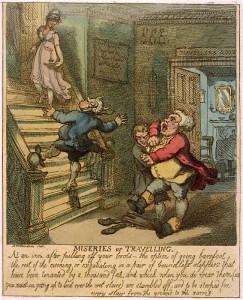 Miseries of Twenty First Century Life (inspired by James Beresford’s 1806 masterpiece).
Miseries of Twenty First Century Life (inspired by James Beresford’s 1806 masterpiece).
Miseries of Travelling.
Arriving at Middlesborough station and finding your way somehow to your B & B in some godawful back street, you are show to your room but after unpacking your suitcase, find that a mini-monsoon has prevented you from leaving your room in search of a pub, and with the town centre over a mile away. The TV doesn’t seem to be working, you can’t get a signal on your mobile , so for entertainment you first inspect the walls for perhaps an old steel engraving of a local beauty spot or two and find instead a reproduction of a rural scene by Helen Allingham and a daub of a cat by a girl aged 8; you then turn in desperation to a couple of shelves opposite the bed and find a Goss china souvenir of Harrogate, a lamp made out of a Chianti bottle, a pottery frog and a leaping dolphin hand crafted from grey resin. You look among some likely looking books and find nothing but three scruffy paperbacks of James Herbert, a mint copy of The Maid of Buttermere by Melvyn Bragg, a slimmer’s cookbook with an introduction by Gloria Hunniford, four Joanna Trollopes, two chicklit novels by women called Charlotte Gibbons and Vicki Manderson, an Argos catalogue of 2003, a battered poetry anthology by C Day Lewis, an odd volume of the works of Walter Scott, undated but c 1880, the autobiography of Alan Shearer, a paperback of popular astrology by Dale Winton, a local bus timetable dated 1985, a 1970s guide to Athens and an old copy of This England with several pages missing… [R.M.Healey]
A Parisian Aladdin’s Cave of Children’s Books
Found in a small magazine/ booklet published in Edinburgh 1953.
– COLLECTORS ITEMS A BIBLIO-TYPOGRAPHICAL MISCELLANY (No. 2, Vol. 1) this piece on Gumuchian – a collector and dealer in children’s books (now a hot collecting area.) His book Les Livres de L’Enfance (Paris, 1930) is still in print (Holland Press modern reprint, right.) Originals are seldom under 1000 euros.
A Parisian Aladdin’s Cave of Children Books
Short and bearded, and somewhat like Tolous-Lautrec in appearance, Victor Gumuchian was one of the great booksellers of the past fifty years. Gumuchian will probably be known for posterity by his immense two volume catalogue of children’s books, “Les Livres de l’Enfance de XVe au XIXe Siecle,” which he published in 1930. But apart from hi knowledge of juvenile literature, he was a great authority on old buildings and books relating to flying and locomotion. He was a man He was a man of erudition, wide knowledge and versatility. A great traveller and linguist, as well as a writer and dramatist, he was also gourmet and a cook of rare quality. He knew where the best food could be eaten in Paris, or, in fact, anywhere in France.
How well I remember my first visit to his bookshop in the Rue Richelieu in Paris. A small window, with perhaps a dozen or two rare books on show; inside, a somewhat dull room, lined with glass covered book shelves full of uncommon and interesting books of all centres. At the end of the room was a small door through which he took me, up a dark winding staircase, such as is only possible in Paris, to a door in the first floor. This he unlocked, and switched on the electric light… I was in an Aladdin’s Cave! There were three rooms, leading one into the other, with thousands of children’s books, all in perfect condition, arranged to show the beautiful points of as many as possible, whether an illustration, a binding, or a page of superb typography. These books were the fruit of his three years’ collecting, and the basis of his great catalogue. I was dumbfounded at what I saw. I had never seen, nor shall I ever see again, such a galaxy of treasures: all so beautifully arranged and delighted displayed. From that moment I became, not an enthusiast, but a fanatic – and have remained so to this day.
M. Gumuchian died in America in 1949, after a series of great misfortunes and after a long illness that caused him much suffering.
A rare friend whom I can never forget.
The Golden Dustmen of Dickens’ time
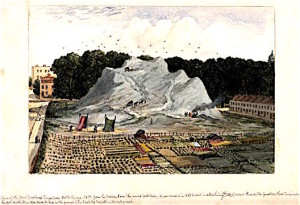 A central character in Dickens’ Our Mutual Friend (1865) is Nicodemus Boffin, nicknamed ‘The Golden Dustman ‘ because of the wealth he inherited from his old employer John Harmon, who had made his fortune as a Dust Contractor at Somers Town. These famous rubbish piles stood where the filthy Maiden’s Lane (now roughly York Way) joined onto Pentonville Road, near where Kings Cross station now stands. Here, just about anything could be found—‘dust ‘ was a Victorian euphemism; there was more likely to be dead dogs ,cats, horses, discarded pots and pans, crockery, shoes, boots, old clothes and all sorts of debris from the surface of roads, including grit, horse dung, dog dirt, as well as the human excrement collected by the scavengers. All this so called ‘dust’, once separated, could be sold to various factory owners for large profits. Dickens, who loved exploring London, once lived in Doughty Street, which is just a mile from the famous Somers Town dust heaps, and must have known them well. He also became friendly with a wealthy Dust Contractor from Islington called Henry Dodd who, at his death in 1881, left a fortune of £111,000. It has been argued that the character of Boffin was based on Dodd.
A central character in Dickens’ Our Mutual Friend (1865) is Nicodemus Boffin, nicknamed ‘The Golden Dustman ‘ because of the wealth he inherited from his old employer John Harmon, who had made his fortune as a Dust Contractor at Somers Town. These famous rubbish piles stood where the filthy Maiden’s Lane (now roughly York Way) joined onto Pentonville Road, near where Kings Cross station now stands. Here, just about anything could be found—‘dust ‘ was a Victorian euphemism; there was more likely to be dead dogs ,cats, horses, discarded pots and pans, crockery, shoes, boots, old clothes and all sorts of debris from the surface of roads, including grit, horse dung, dog dirt, as well as the human excrement collected by the scavengers. All this so called ‘dust’, once separated, could be sold to various factory owners for large profits. Dickens, who loved exploring London, once lived in Doughty Street, which is just a mile from the famous Somers Town dust heaps, and must have known them well. He also became friendly with a wealthy Dust Contractor from Islington called Henry Dodd who, at his death in 1881, left a fortune of £111,000. It has been argued that the character of Boffin was based on Dodd.
A contemporary sketch of the Somers Town site is dated 1836, but doubtless contractors had been adding to the muck heaps for many years up this date. Scavengers are depicted clambering over the filthy heaps in search of the more valuable items to sell on, a process that still takes place in some third world countries. It is interesting to find, therefore, a London Times classified advertisement of December 6th 1820, when Dickens was a boy of eight, requesting Dust Contractors to tender for a contract in Chelsea.


